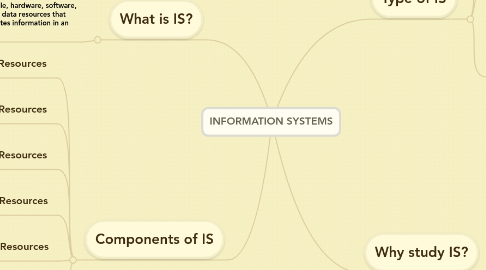
1. What is IS?
1.1. An organized combination of people, hardware, software, telecommunications networks, and data resources that collects, transforms, and disseminates information in an organization.
1.1.1. Input
1.1.1.1. capture the data to be processed
1.1.2. Processing
1.1.2.1. change the data into information
1.1.3. Output
1.1.3.1. disseminate the information product to its destination
1.1.4. Feedback
1.1.4.1. Data about the performance of the system
1.1.5. Control
1.1.5.1. monitoring the feedback to determine if the system is meeting its objectives
2. Components of IS
2.1. People Resources
2.1.1. IS Specialists
2.1.2. End Users
2.2. Hardware Resources
2.2.1. Machines
2.2.2. Media
2.3. Software Resources
2.3.1. Programmes
2.3.2. Procedures
2.4. Data Resources
2.4.1. Data
2.4.2. Information
2.5. Network Resources
2.5.1. Communications Media
2.5.2. Network Infrastructure
2.6. System Activities
2.6.1. Input of Data Resources
2.6.2. Processing of Data into Information – organize, analyze, and manipulate data
2.6.3. Output of Information Products – dissemination of information products to appropriate end users
2.6.4. Storage of Data Resources
2.6.5. Control of System Resources – monitoring feedback to assure the system meets its performance standards
3. Type of IS
3.1. Operations Support Systems
3.1.1. Transaction Processing Systems
3.1.2. Process Control Systems
3.1.3. Enterprise Collaboration Systems
3.2. Management Support Systems
3.2.1. Management Information Systems (MIS)
3.2.2. Decision Support Systems (DSS)
3.2.3. Executive Information Systems (EIS)
3.3. Other Categories of Information Systems
3.3.1. Expert Systems
3.3.2. Knowledge Management Systems
3.3.3. Functional business systems
3.3.4. Strategic information systems
3.3.5. Cross-functional information systems
4. Why study IS?
4.1. Improving efficiency and effectiveness
4.2. Managerial decision making
4.3. Workgroup collaboration
4.4. Efficiency
4.4.1. Minimize Costs
4.4.2. Minimize Time
4.4.3. Minimize Use of Information Resources
4.5. Effectiveness
4.5.1. Support an organization’s business strategies
4.5.2. Enable its business processes
4.5.3. Enhance organizational structure and culture
4.5.4. Increase customer business value
